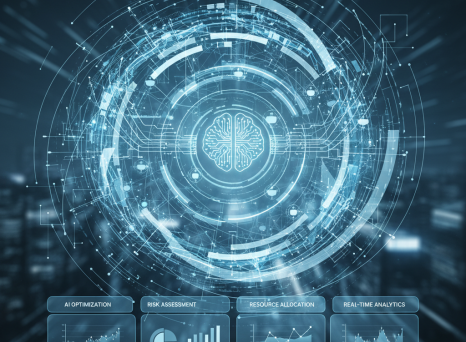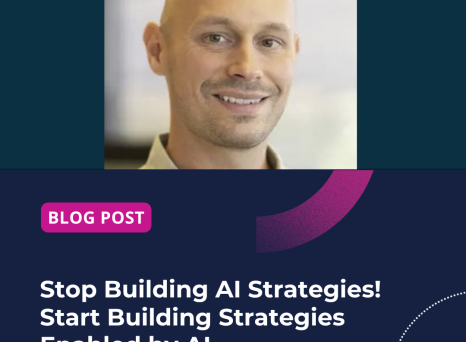In this interview, we spoke with the founder and Chairman of Planisware, Pierre Demonsant, about the company's journey, the role of AI in its solutions, and the exciting developments on the horizon. Here's an in-depth look at how Planisware has been looking at the future of project management since the beginning of its history.
Hello Pierre, you’re one of the Planisware founders, can you tell us a little bit about the history of AI within Planisware?
Pierre Demonsant: The first thing you need to know is that, as Planisware founders, we first met in the AI Department of Thales, a French group, while working in AI in the '90s on expert systems and the beginning of machine learning. When we started Planisware, we always thought that at some stage we should integrate AI into our products. We've always been looking at what's going on in the AI field.
How did you transition into using AI in your products?
Pierre Demonsant: About six years ago, we started to build a team because there were new machine learning algorithms emerging that were very good for creating forecasting models with our customer data. So, we had a team from a French lab, and we started to develop our predictive engine.
Can you tell us more about it?
Pierre Demonsant: Basically, it's a system that learns from customer data and allows you to make forecasts, for example, the duration of a task or the number of resources needed to do some work. We introduced this new module five years ago with some customers testing it, but I think the market wasn't very ready for that back then.
Which is not the case anymore!
Pierre Demonsant: Yes, today, we see a lot of demand for this module from our customers because people are more aware of what AI can do.
What do you consider the biggest challenge of implementing AI in PPM?
Pierre Demonsant: When you want to make forecasts with your data, it's very important to focus on data quality. If you don't have good quality data, you won't have good quality forecasts. It's important to invest in data quality.
How is Planisware helping customers to tackle this key challenge?
Pierre Demonsant: We've been delivering a new data quality analysis module that helps them improve the quality of their data and set up some rules to perform better with their data. That's the first step of the AI plan we’re offering to our customers.
Are you applying AI technologies to other portfolio management use cases?
Pierre Demonsant: More recently, what has been coming is what we call Large Language Models (LLMs). There is a lot of noise about it, and we have been trying to figure out what we can do with it. The problem with LLMs is that they all focus on language, answering questions, and generating text. In portfolio management, we're talking about numbers, duration, schedules, and so on.
So, what was your first step in leveraging the benefits of Large Language Models?
Pierre Demonsant: The first thing we have been doing is improving our bot, Oscar. Now, with the LLM, Oscar can answer your questions better, especially questions about the documentation in Planisware. If you ask a question about how to do something, it will give a much nicer answer than before.
And beyond finding the right information, does it assist PMOs by generating smart contents?
Pierre Demonsant: Yes, we've also been generating content with larger models. These LLMs are trained on data from the web and books. What's interesting is that in our space, especially in life sciences, which is a regulated business, the Large Language Models can provide very smart answers to questions like "How can I perform this clinical trial?" They will bring you templates, which is quite good if you don't already have these templates in your database. We can also provide some good ideas to identify the risks of some activities.
Do you already have feedback on how it’s used by your customers?
Pierre Demonsant: We integrated this ability to generate content with Planisware last year. It's working well in some areas and less in others, where there isn't much data available on the web. For example, in defense, everything is confidential, so Oscar won't be able to provide good content. But if you're working in life sciences or areas well documented on the web, it's working quite well. Large Language Models also bring some very interesting features.
Do you mean that there is more to come with LLMs?
Pierre Demonsant: We are currently working on the ability to understand the content of a text. Before, when we wanted to retrieve some informational text, you had to look at words. Now we can look at the meaning of the words, and it's quite interesting.
How does it apply to the project management world?
Pierre Demonsant: We've delivered a module called “Talk” several years ago with the ability to aggregate discussions on objects. So basically, if you have emails or team discussions, you can aggregate discussions on a project, an activity, or whatever. With the Large Language Model, we can understand what is in these discussions and interpret the data to give you some indicators. For example, we can tell you if many people are talking about problems, issues, or bugs in a project, and you can have some metrics about that.
So, you can react faster or even anticipate any blockers! Do you have other practical examples?
Pierre Demonsant: Another interesting feature is looking at the description of an activity and understanding what it is. For example, if you are starting a new project and describe an activity, the system can retrieve a similar work in your database, a work which is similar in meaning but not exactly in words. People can express things differently, so you wouldn't be able to retrieve this similar work just using words. But the system understands what you are writing and can say, "Okay, you have somebody who has performed similar work in the company. Maybe you should look at it and take inspiration from it." It really brings a better ability to reuse and use the knowledge you have in your database.
It seems that it really helps your customers build a common base of knowledge and practices that anybody involved in project management can access.
Pierre Demonsant: Exactly! And if we follow the same idea, it will also help you to structure your data and get better reporting. For example, we are working on what we call Auto-tagging. If you have not set up activity types in Planisware, you are just putting descriptions in your activities. Now with the Large Language Model and what we call argument generation, you can have Planisware identifying that this activity is of a certain type: it's a quality assessment work, development work, or integration work. It's quite interesting because if your data is not well-structured, the system will dynamically find a way to structure it. It will help to organize and retrieve the data.
So, if we come back to what you said at the beginning of the interview, structured data will also help you to get better predictions?
Pierre Demonsant: Yes, the predicting model we developed five years ago uses the structure you set up in the database. With that, you can use information stored in text to do better forecasts.
Many interesting and practical examples that will accelerate work and make projects have a stronger business impact!
Pierre Demonsant: Yes, as you can see, plenty of nice things are coming to Planisware. We will bring them with the next release, and I'm sure we'll find other nice ideas to increase the value of our product and bring more value to you in the future.
Want to learn more about Artificial Intelligence? Explore how Planisware can improve your decision-making in projects through AI.




